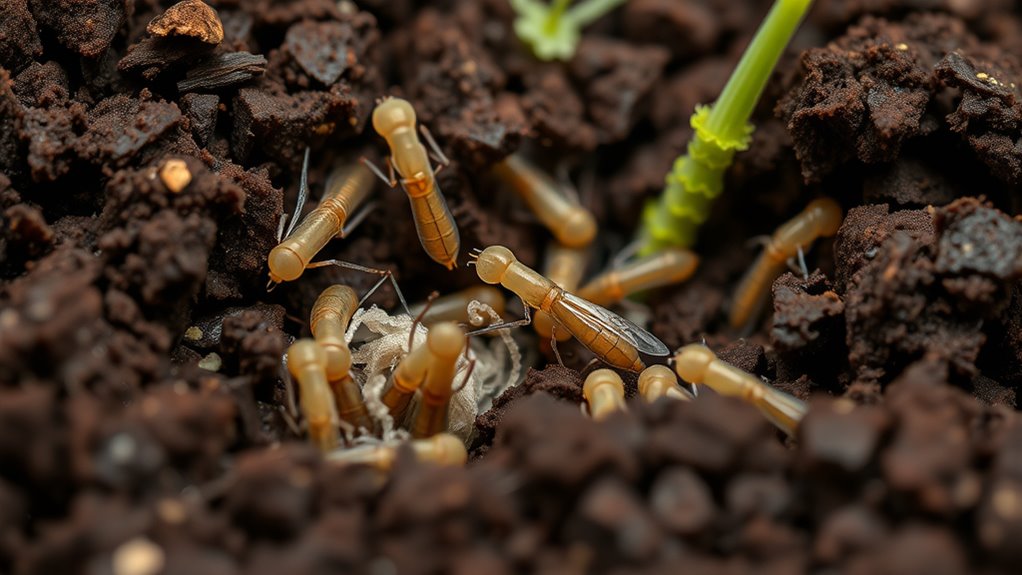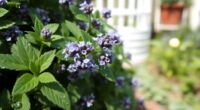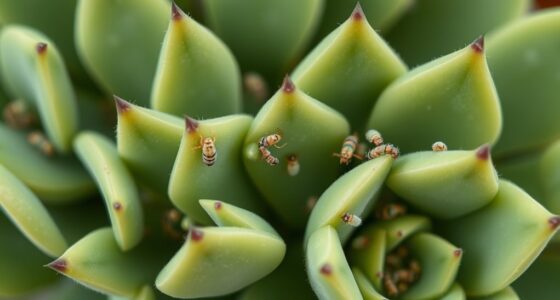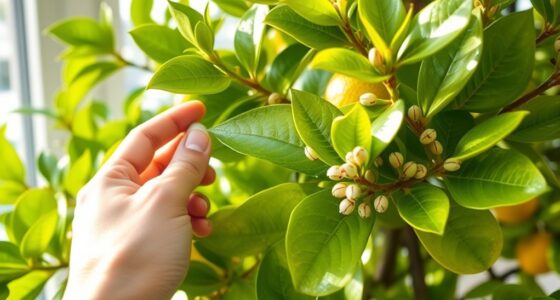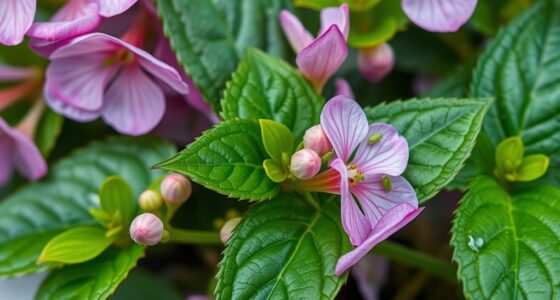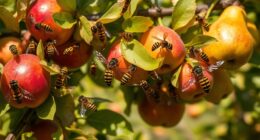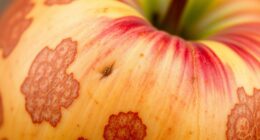Fungus gnats thrive in moist, organic-rich potting soil, with adults attracted to damp conditions and larvae feeding on roots. To break their life cycle without chemicals, let the soil dry out between waterings, improve drainage, and add organic mulches or compost tea to boost beneficial microbes. Introducing natural predators like predatory nematodes can also help control larvae. Keep your plants healthy and avoid overwatering, and you’ll find effective ways to manage these pests effectively.
Key Takeaways
- Fungus gnats lay eggs near soil surface; larvae develop in damp, organic-rich soil, damaging roots and causing plant stress.
- Maintaining proper soil drainage and allowing the top inch to dry disrupts the gnat life cycle naturally.
- Introduce beneficial predators like predatory nematodes or mites to control larvae without chemicals.
- Use organic mulches and compost tea to promote healthy soil microbes that outcompete gnat larvae.
- Repot plants with sterilized, well-draining soil and remove infested material to prevent reinfestation.
Understanding the Fungus Gnat Life Cycle

Understanding the fungus gnat life cycle is key to managing and preventing infestations. Fungus gnat behavior plays a big role, especially since adults are attracted to moist, organic-rich soil. The soil pH influence is vital because larvae thrive in slightly acidic to neutral conditions, typically pH 6.0 to 7.0. When soil remains damp and has the right pH, it creates an ideal environment for eggs to hatch and larvae to develop. As adults lay eggs near the soil surface, they complete their cycle quickly—within a few weeks—if conditions stay favorable. Knowing how soil pH and moisture levels affect fungus gnat behavior helps you disrupt their lifecycle, reducing infestations without chemicals. Soil conditions such as moisture and pH are crucial factors that influence the success of non-chemical pest management strategies. Controlling these factors is essential for effective, non-chemical pest management.
Identifying Signs of Infestation
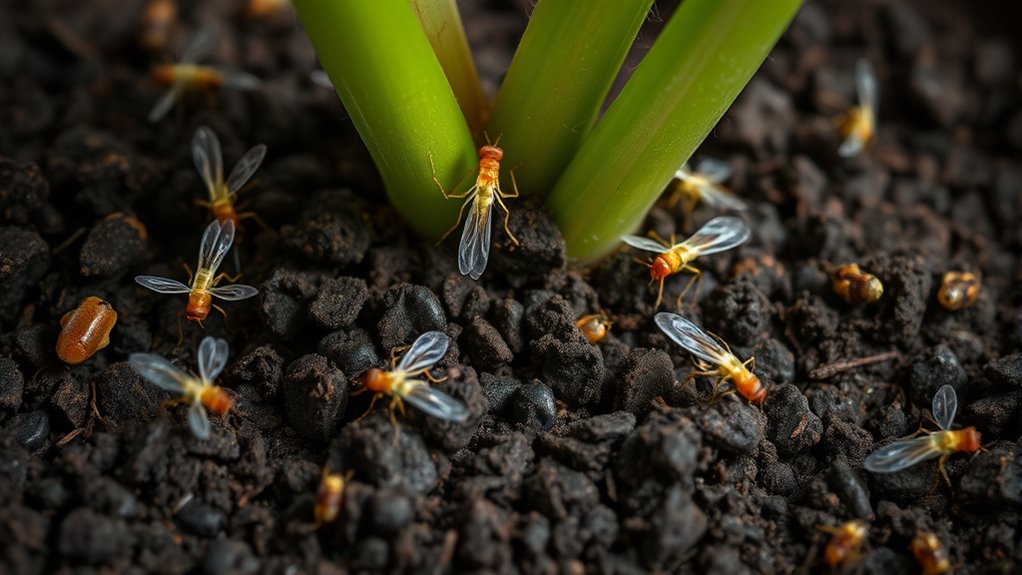
You might notice tiny flying gnats buzzing around your plants, signaling an infestation. Check the soil for small larvae wriggling just beneath the surface, which indicate ongoing problems underground. Additionally, watch for roots that look damaged or rotting, as this often results from gnat activity harming your plant’s health. Recognizing high moisture levels can help identify conditions that promote fungus gnat proliferation.
Visible Flying Adults
Noticing tiny, fluttering adults circling above your indoor plants is a clear sign of a fungus gnat infestation. Adult gnat identification reveals small, dark flies about 1/8 inch long with long legs and a slender body. Their flying gnat behavior includes erratic, quick movements near the soil surface or around plant foliage. To confirm, look for:
- Small, black or dark gray flies hovering in clusters.
- Persistent buzzing sounds near the soil.
- Flies landing on plant leaves or pot rims.
- Increased activity during warm, humid conditions.
- Understanding Narcissistic behaviors can help you better recognize and address underlying issues related to pests or plant health.
These signs indicate adult gnats are active and reproducing. Recognizing flying gnat behavior helps you identify the presence of gnats early, so you can take action before larvae damage your plants.
Larvae in Soil
Larvae in the soil are the primary cause of plant damage during a fungus gnat infestation. You might notice tiny, translucent larvae wriggling just beneath the soil surface or around the roots. High indoor humidity creates ideal conditions for larvae to thrive, so keep an eye on moisture levels. If your soil feels consistently damp, it increases the likelihood of infestation. To prevent further issues, consider soil sterilization before planting or repotting. Regularly inspecting the soil for larvae helps you catch problems early. Removing decaying organic matter and avoiding overwatering also reduces larvae presence. Maintaining proper soil drainage and moisture levels helps limit the gnat population and protect your plants from damage caused by these larvae. By monitoring soil conditions and practicing soil sterilization, you can limit the gnat population and protect your plants from damage caused by these larvae.
Damaged Plant Roots
When fungus gnat larvae feed on plant roots, they cause visible damage that can weaken your plants. You might notice plant root damage, such as brown or rotted roots, or roots that appear chewed or frayed. This indicates pest habitat disruption, as the larvae disturb the root system. To identify infestation signs, look for:
- Wilting or yellowing leaves despite proper watering
- Stunted plant growth or poor development
- Excessive soil moisture or mold on the soil surface
- Roots that are brown, slimy, or have a decayed appearance
These signs point to fungus gnat activity and the resulting plant root damage. Recognizing them early helps you take non-chemical steps to control the problem before it worsens.
The Role of Moisture and Soil Conditions
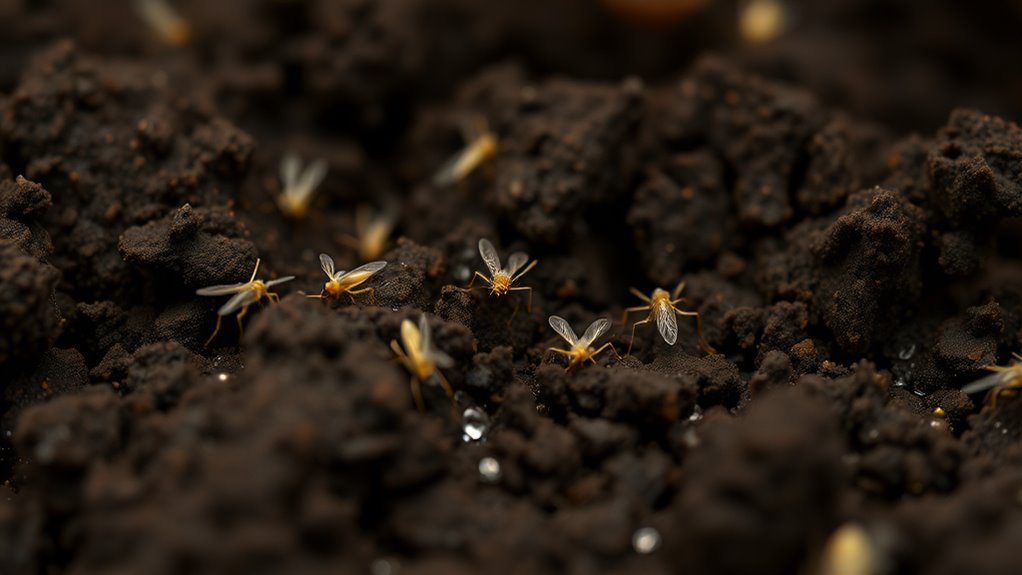
If your soil stays too wet, fungus gnats will thrive. Make sure your soil has good aeration and drains well to keep moisture levels balanced. Proper soil drainage is key to preventing conditions that attract these pests. Additionally, maintaining a consistent watering schedule helps to avoid over-saturation and creates a less hospitable environment for fungus gnats by promoting healthy soil conditions.
Excess Water Levels
Excess water in potting soil creates ideal conditions for fungus gnat larvae to thrive. When the soil stays overly moist, it promotes soil compaction, reducing air pockets and making it harder for roots to breathe. This damp environment encourages gnat eggs to hatch and larvae to feed on organic matter. To prevent this, consider these points:
- Avoid overwatering your plants; let the top inch of soil dry out before watering again.
- Use well-draining soil to minimize excess water retention.
- Improve soil structure by mixing in organic matter to reduce compaction.
- Monitor moisture levels regularly to ensure they stay within an ideal range.
Controlling excess water helps disrupt the lifecycle of fungus gnats and keeps your plants healthier.
Soil Aeration Importance
Proper soil aeration plays a crucial role in maintaining healthy plant roots and preventing pest issues like fungus gnats. When soil isn’t well-aerated, moisture becomes trapped, creating ideal conditions for fungus gnats to thrive. Good soil aeration ensures oxygen reaches the roots, supporting plant health and vitality. It also helps regulate moisture levels, preventing soil from becoming waterlogged or overly compacted. Without proper aeration, roots can suffocate, weakening your plants and making them more susceptible to pests. To improve soil aeration, gently loosen the soil, add organic matter, or incorporate coarse materials like perlite. Regularly checking and maintaining optimal soil conditions keeps your plants vigorous and minimizes the risk of fungus gnat infestations. Healthy soil is key to thriving plants and pest prevention. soil aeration is especially important in maintaining the right balance of moisture and oxygen for plant roots.
Soil Drainage Effect
Moisture levels and soil conditions directly influence the health of your plants and the likelihood of pest problems like fungus gnats. Proper drainage prevents water from pooling, which creates ideal breeding spots for gnats. Poor drainage can cause soil compaction, reducing air flow and increasing moisture retention. Adding organic matter improves soil structure, enhancing drainage and aeration. To optimize soil drainage, consider these points:
- Avoid overwatering; let the topsoil dry before watering again.
- Incorporate organic matter like compost to improve soil texture.
- Loosen compacted soil to promote better water flow.
- Use well-draining soil mixes suited for your plants.
- Incorporating practices like soil aeration can help maintain proper soil health and reduce moisture buildup.
Maintaining proper soil moisture and avoiding compaction are essential for reducing fungus gnat issues and supporting healthy plant growth.
Natural Predators and Biological Control Options

To naturally control fungus gnats in your potting soil, introducing beneficial predators can be an effective strategy. Beneficial insects like predatory nematodes and certain types of predatory mites act as biological agents that target fungus gnat larvae. These biological agents are applied directly to the soil, where they seek out and consume the larvae, breaking the gnat life cycle. You can purchase these natural predators from garden centers or online suppliers. Using beneficial insects is environmentally friendly and reduces the need for chemical pesticides. Keep in mind that consistent application and maintaining a healthy, moist soil environment enhance their effectiveness. Promoting AI-driven diagnostics can help identify pest infestations early, allowing for targeted and timely biological interventions. By encouraging beneficial insects in your soil, you create a natural, ongoing defense against fungus gnat infestations.
Proper Watering Techniques to Discourage Gnats
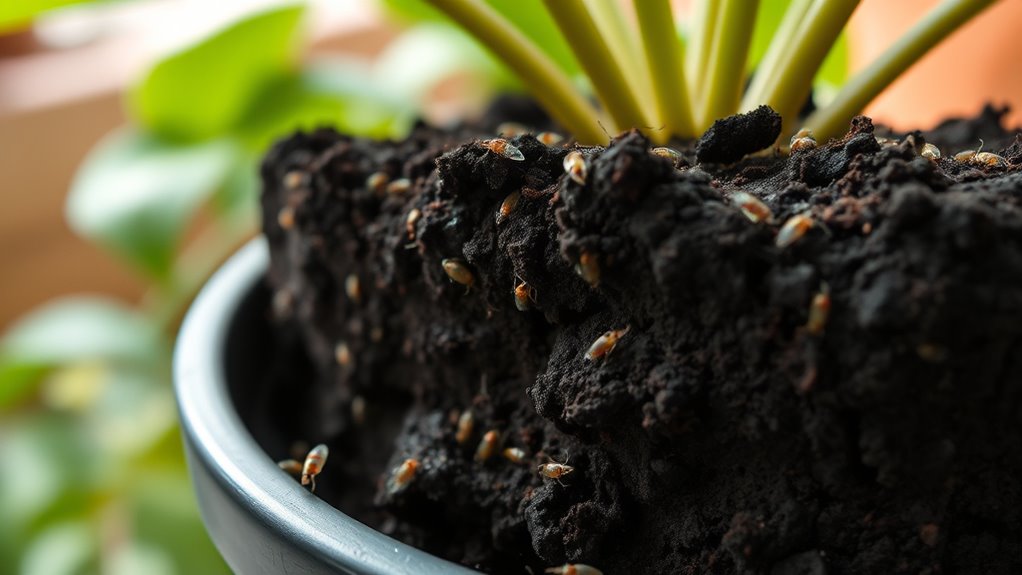
Since fungus gnats thrive in consistently damp soil, adjusting your watering habits can considerably reduce their populations. Maintaining proper soil moisture is key. Here are four tips to help you do so:
- Water only when the top inch of soil feels dry to the touch.
- Use a watering schedule that allows the soil to dry out between waterings.
- Ensure pots have proper drainage to prevent excess moisture buildup.
- Avoid overwatering, especially in cooler or low-light conditions where evaporation is slower.
- Proper soil moisture levels are essential for discouraging fungus gnat infestations and promoting healthy plant growth.
Soil Treatments and Organic Amendments
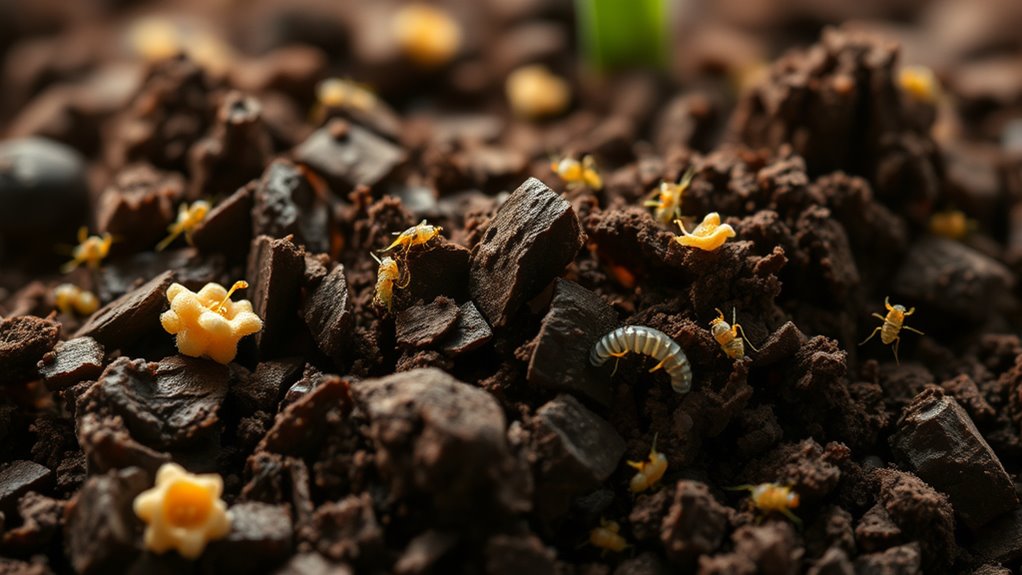
Applying soil treatments and organic amendments can be an effective way to combat fungus gnats naturally. You can start by drenching your soil with compost tea, which boosts beneficial microbes that outcompete fungus gnat larvae and suppress their development. Additionally, applying organic mulches like straw, wood chips, or bark helps create a barrier that deters adult gnats from laying eggs and reduces surface moisture, which larvae need to thrive. These mulches also promote healthy soil ecology, further discouraging fungus gnat infestations. Regularly using compost tea and organic mulches creates an environment unfavorable for fungus gnats, breaking their life cycle without relying on chemicals. Consistent application of these organic strategies can markedly reduce gnat populations over time. Incorporating knowledge about soil treatments in IRA investing can also help optimize soil health and pest management in your garden.
Repotting and Soil Replacement Strategies
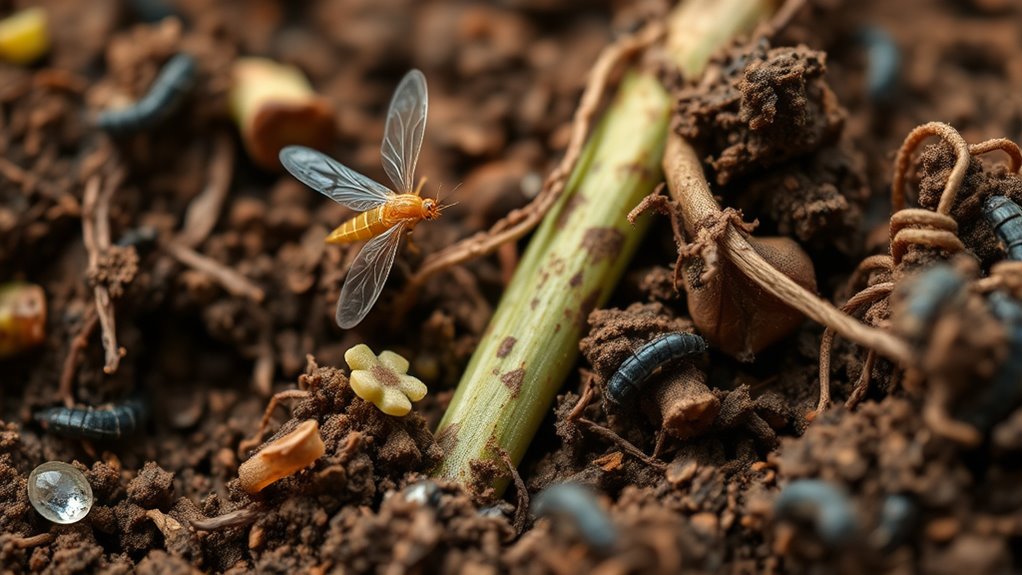
When dealing with persistent fungus gnat problems, repotting your plants and replacing contaminated soil can be highly effective. Start by carefully removing the plant from its current pot and inspecting the roots. Use proper repotting techniques to minimize stress. Next, consider soil sterilization by baking or steaming the old soil to kill larvae and eggs. Here are some key strategies:
- Remove all visible soil from roots and discard heavily infested soil.
- Sterilize old soil or replace it entirely with fresh, insect-free potting mix.
- Use a clean, well-draining pot to prevent moisture buildup.
- Ensure your new soil is dry before planting to discourage gnats.
These steps help break the life cycle and reduce reinfestation chances effectively.
Environmental Adjustments to Prevent Reinfestation

To prevent fungus gnats from returning, you need to make environmental adjustments that reduce moisture and disrupt their breeding cycles. Proper compost management is essential; avoid overwatering compost and ensure it dries out between watering sessions. Consider using well-draining potting mixes to keep soil moist but not soggy. Additionally, select plants suited for your environment, as healthy, vigorous plants are less attractive to gnats. Remove decaying plant matter and avoid placing pots in overly humid areas. Elevate potted plants to improve air circulation and allow excess moisture to evaporate. These steps help create an environment that’s less inviting for gnats, breaking their life cycle and preventing reinfestation. Consistent upkeep guarantees your indoor garden stays pest-free without chemical treatments.
Monitoring and Maintaining a Pest-Free Indoor Garden

Regular monitoring is essential to keep your indoor garden free of pests like fungus gnats. Check your plants frequently for signs of infestation, such as adult gnats flying around or larvae in the soil. To maintain a pest-free environment, consider these steps:
Regularly inspect your indoor garden to prevent fungus gnat infestations.
- Use soil sterilization methods before planting to eliminate gnat eggs and larvae.
- Opt for pest-resistant plants that are less attractive to fungus gnats.
- Keep the topsoil dry, as moisture attracts gnats.
- Regularly inspect and remove any fallen leaves or debris that can harbor pests.
Frequently Asked Questions
Can Fungus Gnats Harm Indoor Plants Beyond Nuisance Levels?
Fungus gnats can harm your indoor plants beyond just being a nuisance, especially if their larvae feed on roots and damage plant health. Poor soil management can increase their presence and risk. To protect your plants, maintain proper watering routines, avoid overwatering, and use non-chemical fixes like sand or beneficial insects. Keeping soil healthy and well-managed helps prevent gnat infestations and preserves your plants’ essentialness.
Are Certain Plant Species More Susceptible to Fungus Gnat Infestations?
Certain plants are more susceptible to fungus gnat infestations due to their soil preferences and plant susceptibility. You might notice that overwatered or poorly-draining soils attract gnats, especially around houseplants like ferns or orchids. These plants often have moisture-retentive soil, making them more vulnerable. To reduce risk, guarantee proper watering and soil drainage, and monitor plants with high susceptibility to prevent infestations from taking hold.
How Long Does It Typically Take to Eliminate Fungus Gnats Naturally?
In the age of knights and dragons, tackling pests like fungus gnats naturally takes patience. Typically, with consistent use of natural remedies like sand, beneficial nematodes, or letting the soil dry out, you can see a significant reduction in infestation duration within two to three weeks. Complete elimination might take up to a month, but persistence helps. Keep monitoring and applying these fixes regularly to guarantee your plants stay gnat-free.
Do Fungus Gnats Spread Plant Diseases Within Indoor Gardens?
You might wonder if fungus gnats spread plant diseases in your indoor garden. While fungus gnat transmission of diseases is rare, their larvae can damage roots, weakening plants and increasing susceptibility to infections. This elevates the disease risk, especially if populations grow unchecked. To protect your plants, control gnat populations early, maintain healthy soil, and avoid overwatering, reducing the chances of disease development linked to these pests.
What Are the Most Common Mistakes When Trying to Control Fungus Gnats Organically?
Thinking you’re a fungus gnat control pro? Think again! The biggest mistakes are overwatering issues that create perfect breeding grounds and composting mistakes that invite gnats in. You might try organic fixes, but neglecting proper watering habits or compost management just fuels their invasion. Stay vigilant—allow soil to dry between waterings, and compost wisely. Otherwise, you’ll keep battling these tiny pests, wasting time and effort.
Conclusion
By understanding the fungus gnat life cycle and maintaining proper soil and watering habits, you can keep these pests at bay. Did you know that over 70% of indoor gardeners report infestations caused by overly moist soil? Regular monitoring and natural controls make a huge difference. With consistent effort, you can enjoy a healthy, pest-free garden. Stay vigilant, and your plants will thrive without the need for harsh chemicals.
